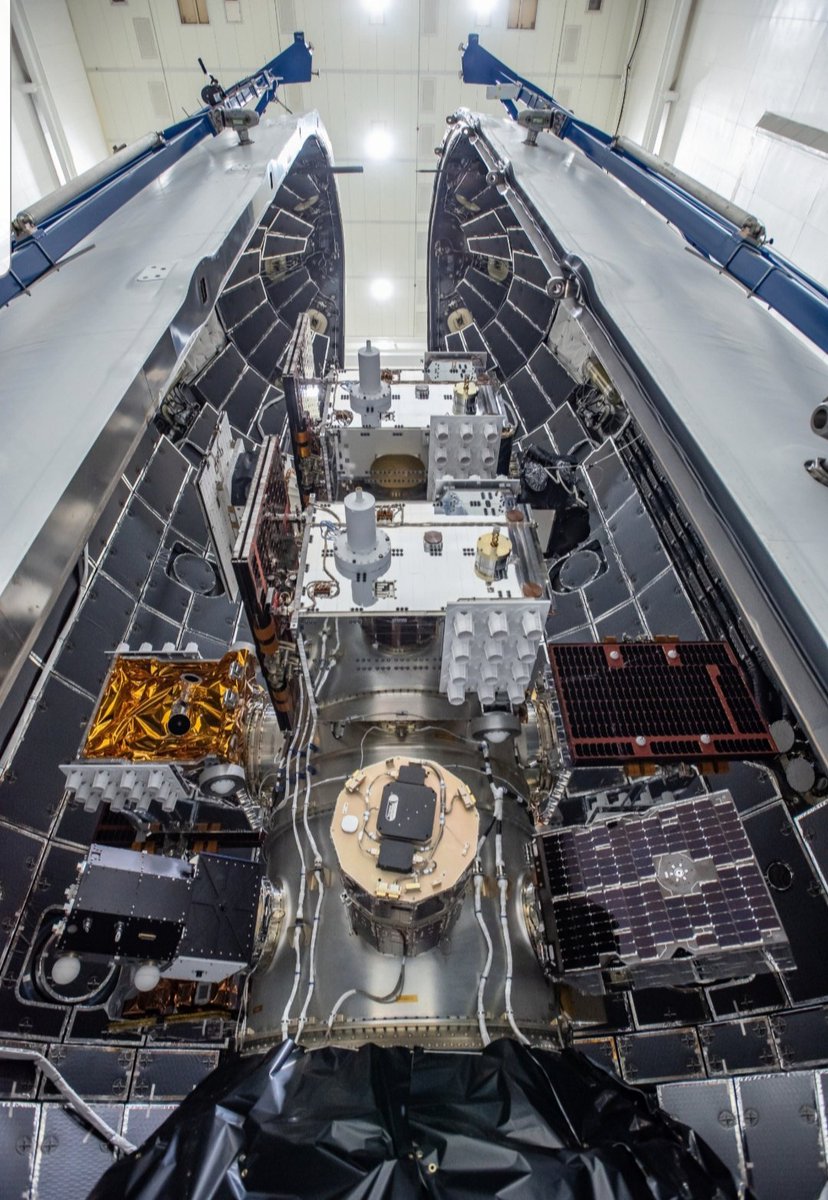This Is What 2 Dozen Satellites Look Like Packed for Launch on a SpaceX Falcon Heavy
Liftoff is set for June 24!

Update, June 24 at 9:20 p.m. EDT: SpaceX has announced they are now targeting a 2:30 a.m. EDT (0630 GMT) launch time, three hours into their original launch window.
SpaceX is gearing up for its busiest Falcon Heavy megarocket launch yet and now, thanks to the U.S. Air Force, we know what the epic rideshare looks like.
When the next SpaceX Falcon Heavy launches on Monday (June 24) from NASA's historic Pad 39A at the Kennedy Space Center in Florida, the heavy-lift rocket will be carrying 24 different satellites for the Air Force's Space Test Program-2 mission. If you're wondering what two dozen satellites look like inside a Falcon Heavy nose cone, wonder no more.
In a Twitter post Tuesday (June 18), the Air Force Space & Missile Systems Center in charge of the STP-2 mission showed just how the 24 satellites are stacked inside the payload fairing.
"The 3,700 kg [8,157 pounds] Integrated payload Stack (IPS) for STP2 has been completed!" Air Force officials wrote in the post. "Have a look before it blasts off on the first DoD Falcon Heavy launch!"
Related: See the Evolution of SpaceX's Rockets in Pictures
The STP-2 mission is scheduled to launch sometime during a four-hour window that opens Monday night at 11:30 p.m. EDT (0330 June 25 GMT). It will be the third Falcon Heavy launch for SpaceX , but the first to carry more than one satellite at time.
Get the Space.com Newsletter
Breaking space news, the latest updates on rocket launches, skywatching events and more!
The first Falcon Heavy mission, a test flight in February 2018, carried a Tesla roadster owned by SpaceX CEO Elon Musk and Starman, a mannequin dressed in an official SpaceX spacesuit. (The Roadster and Starman are still out there in deep space.)
A single massive satellite, the 14,241-pound (6,460 kilograms) Arabsat 6A launched atop SpaceX's second Falcon Heavy on April 11 of this year. The two first-stage side boosters used to launch Arabsat 6A will be reused on the STP-2 mission, SpaceX has said.
The 3700 kg Integrated Payload Stack (IPS) for #STP2 has been completed! Have a look before it blasts off on the first #DoD Falcon Heavy launch! #SMC #SpaceStartsHere pic.twitter.com/sEUUDx5kswJune 18, 2019
The 24 satellites of the STP-2 mission comprise a diverse group of spacecraft built by NASA, the U.S. military, National Oceanic and Atmospheric Administration, student teams from universities. They include a NASA atomic clock, a satellite to test "green" spacecraft propellant and the LightSail 2 solar sail for the Planetary Society, among others.
"The STP-2 mission will be among the most challenging launches in SpaceX history with four separate upper-stage engine burns, three separate deployment orbits, a final propulsive passivation maneuver and a total mission duration of over six hours," SpaceX wrote in a mission description.
SpaceX added that the ability to carry many satellites at once, as well as launch with used boosters, are key milestones for the mission.
"The STP-2 multi-manifest (rideshare) launch will demonstrate the capabilities of the SpaceX Falcon Heavy launch vehicle and provide critical data supporting certification for future National Security Space Launch (NSSL) missions," SpaceX officials said. "In addition, SMC will use this mission as a pathfinder for the development of mission assurance policies and procedures related to the reuse of launch vehicle boosters."
SpaceX regularly reuses the first stage boosters of its smaller Falcon 9 rockets, as well as its uncrewed Dragon cargo ships that deliver NASA cargo to the International Space Station. SpaceX has been steadily developing reusable rocket technology to lower the cost of spaceflight.
Finally, while 24 satellites may seem like a lot, SpaceX has actually launched more at the same time on its Falcon 9 rockets. Last year, the company launched 64 tiny satellites at the same time as part of a rideshare mission brokered by the company Spaceflight.
Just last month, SpaceX launched the first 60 of its Starlink internet satellites to lay the foundation of a constellation aimed to number in the thousands of satellites.
Editor's note: This story has been updated to correct the launchpad for SpaceX's Falcon Heavy rocket. It is Launch Pad 39A, not Pad 39B.
- SpaceX's Falcon Heavy: Latest News, Images and Video
- In Photos: SpaceX's 1st Falcon Heavy Rocket Test Launch Success!
- SpaceX's Huge Falcon Heavy Rocket: How It Works (Infographic)
Email Tariq Malik at tmalik@space.com or follow him @tariqjmalik. Follow us @Spacedotcom and Facebook.
Join our Space Forums to keep talking space on the latest missions, night sky and more! And if you have a news tip, correction or comment, let us know at: community@space.com.

Tariq is the Editor-in-Chief of Space.com and joined the team in 2001, first as an intern and staff writer, and later as an editor. He covers human spaceflight, exploration and space science, as well as skywatching and entertainment. He became Space.com's Managing Editor in 2009 and Editor-in-Chief in 2019. Before joining Space.com, Tariq was a staff reporter for The Los Angeles Times covering education and city beats in La Habra, Fullerton and Huntington Beach. In October 2022, Tariq received the Harry Kolcum Award for excellence in space reporting from the National Space Club Florida Committee. He is also an Eagle Scout (yes, he has the Space Exploration merit badge) and went to Space Camp four times as a kid and a fifth time as an adult. He has journalism degrees from the University of Southern California and New York University. You can find Tariq at Space.com and as the co-host to the This Week In Space podcast with space historian Rod Pyle on the TWiT network. To see his latest project, you can follow Tariq on Twitter @tariqjmalik.









